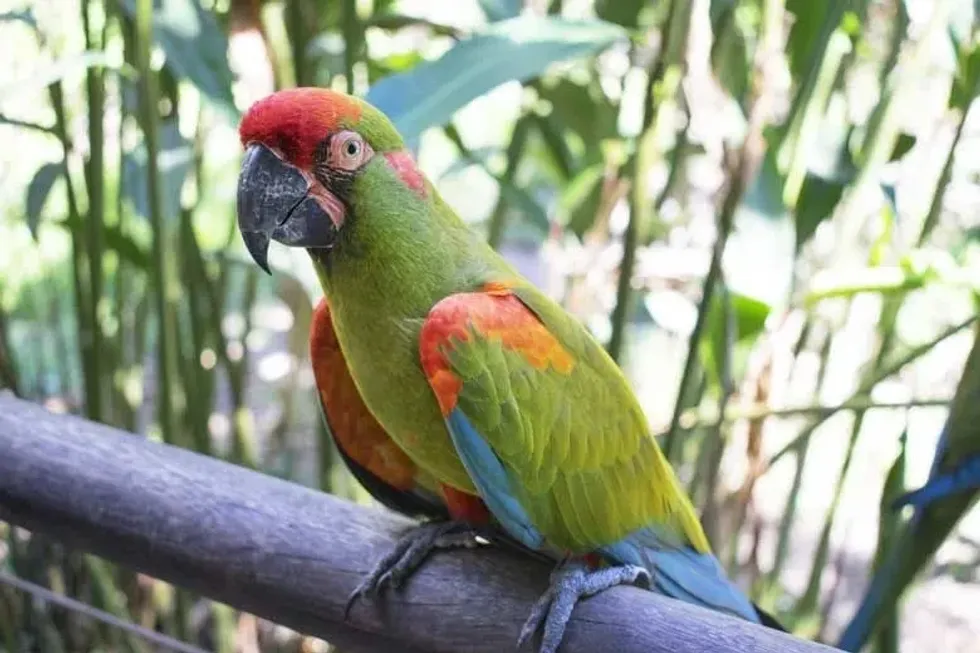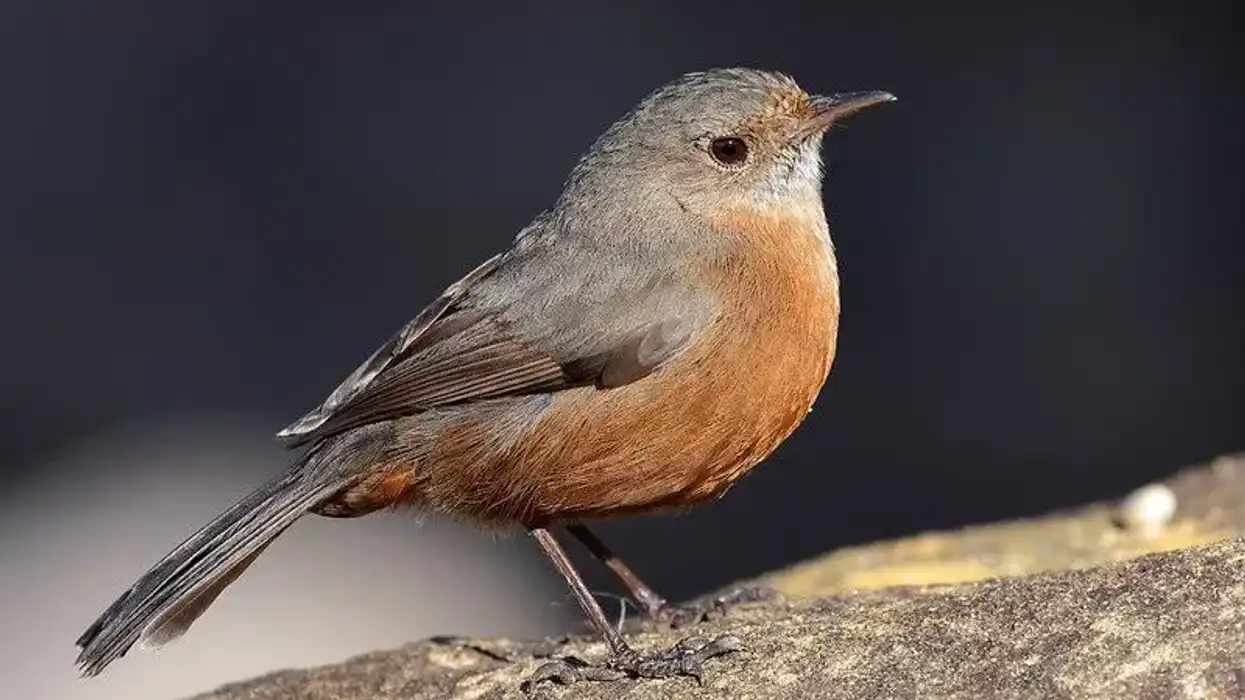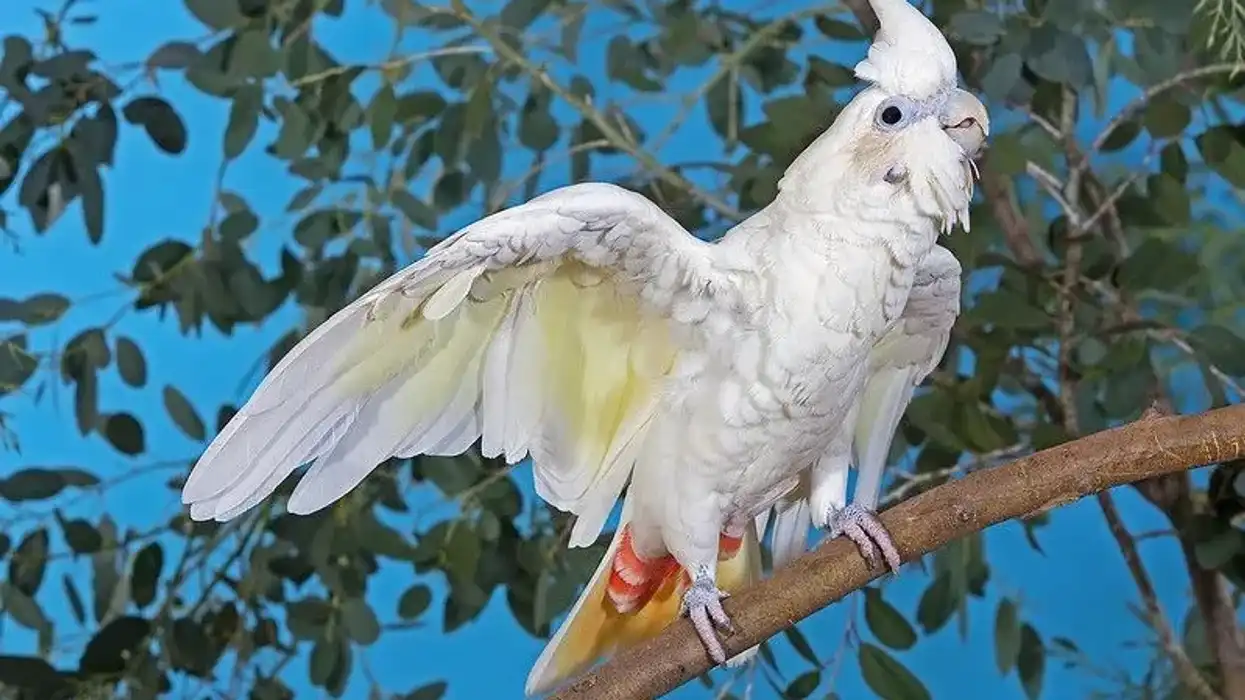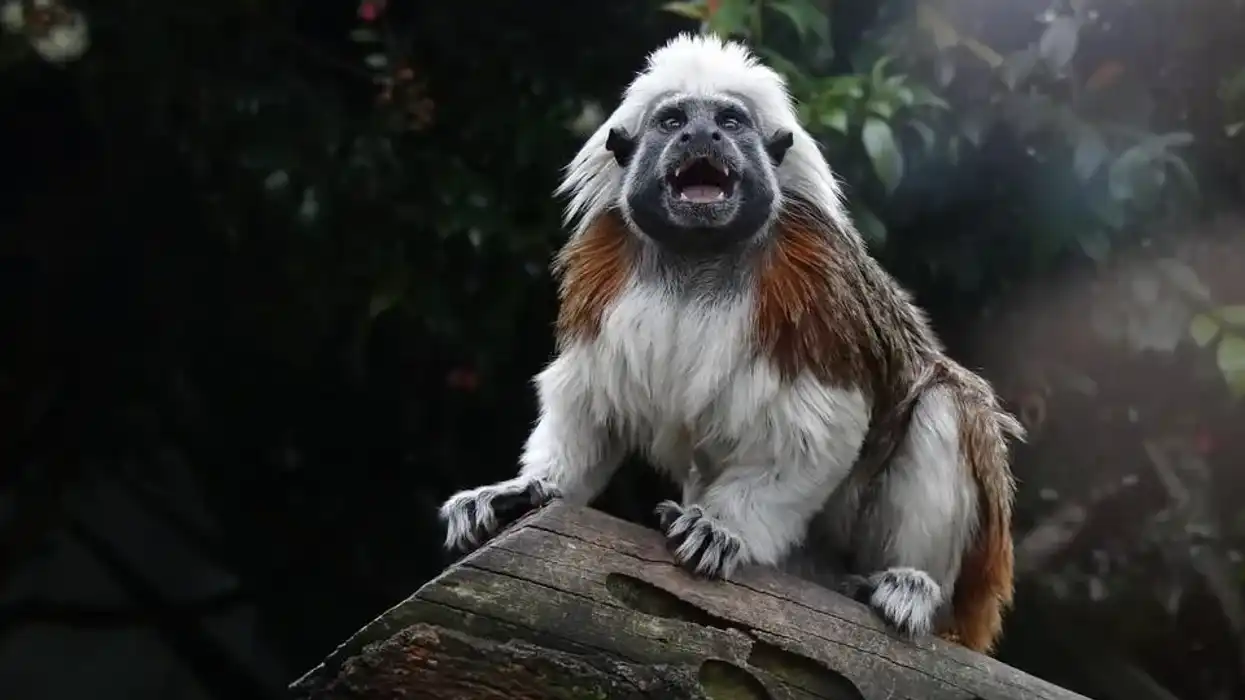The red-fronted macaw, Ara rubrogenys, is a simple colored macaw that does not possess many stunning colors or patterns on its plumage like other macaws. However, it is still very unique and rare.
It is a medium-sized parrot whose plumage is predominantly green and has an orange-red forehead along with an orange-red crown. Its common name originated from these characteristic colored parts.
It has a stunning red patch on top of its ears, teal-blue-colored wing feathers, and red-colored shoulders and thighs. The tip of its long tail is olive-green and ranges from teal-blue to green in color. The underside of its tail is colored in a dazzling yellow.
The eyes of this parrot are a shade of orange and around them is a small patch of bare pale skin. Its beak is quite large and is gray-black in color, with its feet also being gray in color.
Males and females do not exhibit sexual dimorphism and look similar to each other. These red-fronted macaws are also known as red-cheeked macaws or Lafresnaye's macaws.
The conservation status of this species is Critically Endangered as per the IUCN as there are less than 1000 individuals in the wild. This endangered macaw can be spotted in southern America.
It resides in subtropical areas that have thorny scrub and thorny trees. It inhabits a semi-arid climate where there are hot days and cold nights.
It can be spotted typically in small semi-desert mountainous regions of Bolivia in South America. It is found in a flock, usually at elevations that range between 3600-8860 ft (1097.2-2700.5 m).
The range of this parrot starts from the Cochabamba Valley's south region and Santa Cruz towards north Chuquisaca and northeast Potosi. Keep reading to learn more about the typical red-fronted macaw personality, habitat, distribution, and behavior!
Found these facts seriously cool? Then you must read our Spix's macaw fun facts and blue-and-yellow macaw surprising facts to go deeper into the macaw world!
Red-Fronted Macaw Interesting Facts
What type of animal is a red-fronted macaw?
The red-fronted macaw, commonly known as a red-cheeked macaw, is a species of macaws. This bird is a herbivore and its diet comprises mainly vegetation, seeds, vegetables, fruits (like Jatropha hieronymii), and nuts.
They range between 21.5–23.5 in (55–60 cm) in length and are quite large. They are famous for being affectionate pets that love to cuddle!
These cute parrots are hated by farmers, as these birds target their crops to feed upon. Many farmers consider them as pests who raid their crops and sadly end up killing these magnificent birds.
What class of animal does a red-fronted macaw belong to?
This bird belongs to the class of Aves as all its macaw relatives do.
How many red-fronted macaws are there in the world?
In 2009, the population of red-fronted macaws in the wild ranged between 1000-4000 birds in the Bolivia Valley area. In 2011, out of 130 pairs counted, only 67-86 were breeding whereas the other 545 birds were either non-breeding or immature.
The entire population in 2011 was 805 birds. The largest populations of these birds can be found in the Pilcomayo, Ríos Grande, Mizque, and Caine Valleys.
Some significant reasons for the decline in their population are illegal capturing of these birds for the pet trade and hunting by local farmers (as they raid their crops). This species of bird is very close to becoming extinct in the wild.
Where do red-fronted macaws live?
The red-fronted macaw lives in south-central Bolivia in southern America where it inhabits a small semi-desert mountainous region. The range of this parrot starts from the Cochabamba Valley's south region and the west of Santa Cruz to north Chuquisaca and northeast Potosi.
It is found in a flock, usually at elevations that range between 3600-8860 ft (1097.2-2700.5 m) on the eastern Andean Slope. The largest populations of these parrots can be found in the Pilcomayo, Ríos Grande, Mizque, and Caine valleys.
What is a red-fronted macaw's habitat?
A typical red-fronted macaw habitat comprises thorny scrub and thorny trees. This bird can be spotted typically in small semi-desert mountainous regions of Bolivia in South America where the climate is semi-arid, with hot days and cold nights.
This species is the only one of all macaw species that inhabits such a climate.
When kept in captivity, the red-fronted macaw cage size must be large, giving ample space for the parrot to extend its wings as well as move around freely. However, just like all large-sized parrots, this bird will be most comfortable when allowed to roam around freely in the home.
Who do red-fronted macaws live with?
Red-fronted macaws are social parrots that can be typically seen in flocks in the wild. However, during the breeding season, the pairs separate themselves from the flock.
The flocks are small and comprise only three to five birds on average. They can be as large as 30 birds if roosting or looking for food.
When roosting, red-fronted macaws have been observed to peck at each other with their beak, wrestle and fence with their beak, toss objects towards each other, and jerk their body when perched on a branch.
How long does a red-fronted macaw live?
The red-fronted macaw lifespan ranges between 25–50 years which is similar to the lifespan of military macaws!
How do they reproduce?
Red-fronted macaws are monogamous birds that mate for life. They are quite romantic birds, as even when it is not the breeding season, they can be seen portraying affectionate behavior like mutual preening, grasping other's beaks, or nibbling the face feathers of one another.
Their breeding season commences in October and persists until April.
Red-fronted macaws only nest once annually. The majority of macaw species nest in the cavities of trees, but as there are none of these in the habitat of the red-fronted macaw, they nest on the steep-sided cliffs of rocky gorges and canyons, typically in crevices.
They have also been observed breeding in palms. The female can lay between one and three eggs that go through the incubation process for 26 days.
The male and the female both tend to their nest and their young who have recently fledged.
The parents, along with their young, join flocks to do activities like roosting and feeding together until next year's breeding season when the pairs will separate themselves from their flock and nest again. These parrots are not territorial typically, but the breeding pairs will immediately defend their nest if they sense an incoming threat.
What is their conservation status?
Red-fronted macaws are classified under the Critically Endangered category by the IUCN as they have faced a significant decline in their population over the past few years.
Their major threats are similar to those of the hyacinth macaw like illegal capturing for the pet trade, ingesting pesticides that were on crops, and hunting by local farmers (as they raid their crops).
Red-Fronted Macaw Fun Facts
What do red-fronted macaws look like?
The adult red-fronted macaw possesses a lush plumage that is predominantly green and has an orange-red forehead along with an orange-red crown. Its common name originated from these characteristic colored parts.
It has a stunning red patch on top of its ears, magnificent long teal-blue-colored flight feathers, and red-colored shoulders and thighs. The tip of its long tail is olive-green and ranges from teal-blue to green in color.
The underside of its tail is colored in a dazzling yellow. The eyes of this beautiful parrot are orange and around them is a small-sized patch of bare pale skin. Its beak is quite large and is gray-black in color, with its feet also being gray in color.
The male bird and the female bird do not exhibit sexual dimorphism and look very similar to each other. Their length varies between 21.5–23.5 in (55–60 cm).

How cute are they?
Red-fronted macaws are very cute birds that make affectionate and adorable pets. These parrots have long teal-blue-colored flight feathers that are absolutely stunning!
How do they communicate?
They communicate vocally via calls that are given when at rest or in flight. Their calls are described as melodious high-pitched notes, growls, squeaks, and shrills.
However, they lack the screechy and harsh quality that other larger macaws possess. Pairs of this species of macaws sing in duets, starting off with loud squawks and ending with chuckles and soft coos.
How big is a red-fronted macaw?
The red-fronted macaw varies between 21.5–23.5 in (55–60 cm) in length with the wings expanding up to 33 in (86 cm) in length when in flight.
How fast can a red-fronted macaw fly?
The red-fronted macaw has a wingspan that varies between 31.5-33.8 in (80 - 86 cm), allowing them to have a powerful flight at a speed of 40 mph (64.3 kph).
How much does a red-fronted macaw weigh?
The weight of the red-fronted macaw ranges between 15-19.4 oz (425-550 g).
What are their male and female names of the species?
The male of this species of macaws can be referred to as a 'cock', whereas the female parrot can be called a 'hen'.
What would you call a baby red-fronted macaw?
The young of this bird can be referred to as a 'chick'.
What do they eat?
The diet of these macaws mainly comprises food such as vegetation, seeds, vegetables, fruits (like Jatropha hieronymii), and nuts. They play an essential role in the dispersal of the seeds from the fruits they devour. They are preyed upon by peregrine falcons!
Are they dangerous?
The typical red-fronted macaw temperament is observed to be very friendly and calm. As a pet, they must be socialized at an early age to prevent anxious behavior in later years. However, they can sometimes be destructive and nippy. They are not aggressive with their mates, however, they are noisy when they breed.
Would they make a good pet?
It is now illegal in many places to keep red-fronted macaw as pets as their population has been continuously declining over the years and is at risk of becoming extinct. Traditionally, as a pet, they are known to be extroverts and have a playful nature.
Did you know...
This magnificent bird has the strength to fly in a sandstorm!
Is the red-fronted macaw the rarest macaw?
No, the red-fronted macaw is not the rarest macaw. Spix's macaw is the rarest of all species of macaws. It is a parrot that has been classified as Extinct In The Wild by the IUCN.
Having your own red-fronted macaw
The average red-fronted macaw price is quite high and this pet can cost approximately $1500. The diet of this pet in captivity can include palm nuts that are rich in oil and calories, formulated foods, seed mixes, fruits, and fresh vegetables.
The red-fronted macaw's care needs include regular baths, proper feeding, and ample space. These parrots are illegal to capture so they cannot currently be kept as pets in most places.
Here at Kidadl, we have carefully created lots of interesting family-friendly animal facts for everyone to discover! Learn more about some other birds from our scarlet macaw fun facts and great green macaw surprising facts pages!
You can even occupy yourself at home by coloring in one of our free printable red-fronted macaw coloring pages!










